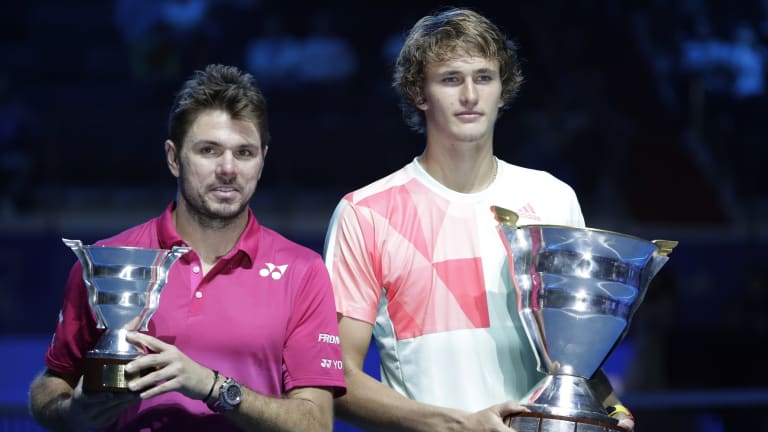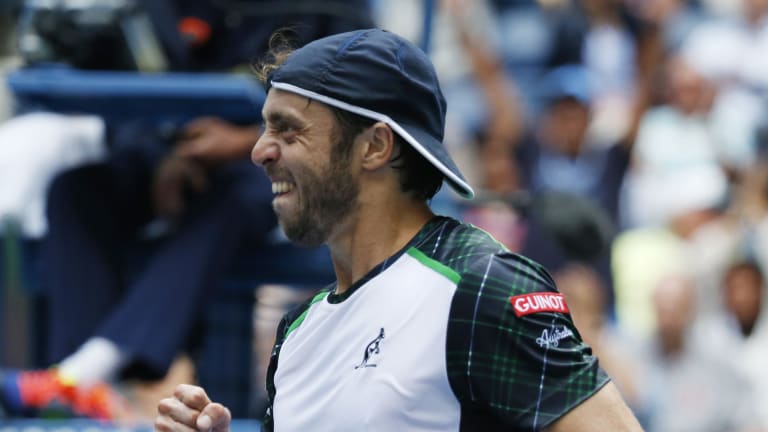In Part Two of our year-end Rally, Kamakshi Tandon and I wonder which was the bigger development in 2016—the game’s youth movement, or its graceful aging? Click here to read Part One.
Hi Kamakshi,
You’re right that the Djoker Slam didn’t get as much media love as it deserved. Like you said, he wasn’t helped by the fact that there were multiple stories coalescing around him in Paris at the same time. As someone who had been watching Novak Djokovic try to win the French Open for 10 years, and complete a career Grand Slam for five, those two quests were my main focus. And unfortunately for Djokovic, he won his fourth straight major at the French Open, which is followed immediately by Wimbledon, where he lost in the third round. There wasn’t much time for him to bask, or for the press to write their accolades, before he had his streak snapped.
Ironically, it was left to Andy Murray, after losing to Djokovic in the French final, to give him a proper tribute and put what he had done in perspective. Murray said that we were lucky to witness an achievement like Djokovic’s—he was the first man since Rod Laver in 1969 to win four straight majors—and that we might not see it again on the ATP side in our lifetimes. Murray was right.
In Serena’s case, I think her 22nd major went slightly under the radar for two reasons. She tied Steffi Graf, but didn’t pass her. And, as you mentioned, there’s still Margaret Court’s 24 out there. It has become fashionable recently to downplay Court’s record because it makes Serena passing Steffi sound like a bigger deal, and because Court won 11 of her Slams at the Australian Open, back when it was a shadow of its current self. (Through the mid-1960s, the Australian Championships wasn’t even the most prestigious tournament in Australia.)
But that’s an arbitrary distinction; you can’t say that the Australian Open only qualifies during certain eras and doesn’t count during other eras. For years, Roy Emerson owned the men’s record for Slams with 12. Six of them came at the Aussie Championships during the 60s, but no one claimed they shouldn’t count. When Pete Sampras finally passed Emmo’s record, it was a widely celebrated accomplishment. We’ll see what happens if and when Serena passes Steffi. Serena has said she “doesn’t want to think about 24,” and I don’t blame her. Breaking Steffi’s 22 will be amazing enough, and not catching Court’s record doesn’t mean she’s below her on the list of women’s greats.
And let me just get a word in about the eternal question that is Davis Cup. I wouldn’t be opposed to changing the format; there’s no doubt that the competition is, as they say, underleveraged and under-marketed. But as a lifelong fan who watches tennis all year, I also like Davis Cup the way it is. I would actually prefer not to see the big-name players who have dominated at the Slams all year; in that sense, I thought this year’s final, where Juan Martin del Potro, Marin Cilic and Federico Delbonis got their shots at glory, was perfect. I may speak for a small minority, but I see enough of the stars the rest of the season.
Kamakshi, you asked what I thought were the biggest developments in tennis in 2016. I had to stop and think about that: What qualifies as a development these days? The sport has seemed very settled the last few years. The Big Four era continues on the men’s side; the Serena era continues on the women’s. The days when the tour calendars were constantly under fire seem to be over. The issue of compensation at the Slams that briefly roiled the game three years ago has passed.
The latest discussions revolve around the time that it takes to play the sport, and whether we should try to shorten it. That issue may start to heat up soon, but it was still on low simmer in 2016.
Even the style of play on both tours is settled: The baseline game rules. It reminds me of the mid-1960s, a time when serve and volley—“the Big Game” popularized by Jack Kramer two decades earlier—was the rule, even on clay. Reading articles from the 60s, you come across a lot of complaints about how one-dimensional tennis had become. But no one could imagine an alternative to rushing the net on every point.
There was no way to foresee that, by the start of the next decade, Bjorn Borg, Jimmy Connors and Chris Evert would begin the game’s long journey back to the baseline. Today there are certainly varieties of baseline tennis; Djokovic is different from Dominic Thiem, who is different from Gael Monfils, and Angelique Kerber is different from Karolina Pliskova, who is different from Agnieszka Radwanska. Personally, I don’t think the sport is dull or one-dimensional now, but no one is doing anything drastically new or different.


